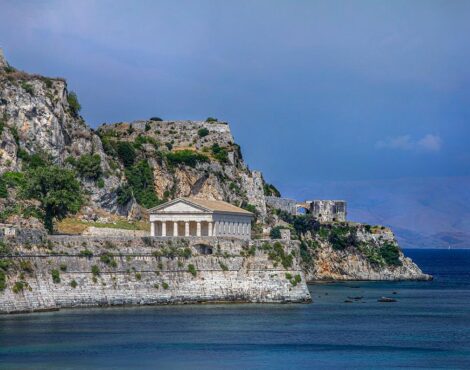Mount Pantokrator rises in the northeast of Corfu and is the highest point of the island at 906 meters. From its summit you can see the whole of Corfu stretched beneath you, the blue line of the Ionian Sea, the coast of Albania across the water, and on very clear days even the mountains of Italy in the distance. Hiking here is not just a climb but a journey through villages, history and nature.
Starting Points and Trails
There are several ways to reach the summit. The most popular routes begin from traditional villages at the foot of the mountain.
-
Old Perithia: This medieval village, partly abandoned and partly restored, is one of the most atmospheric places to start. The trail winds up through stone paths, fields and oak trees. It takes about two to three hours depending on pace.
-
Strinilas: A high village already close to the mountain’s slopes. From here the ascent is shorter, around one hour, and passes through open landscapes with wide views.
-
Loutses and Petaleia: These villages offer alternative routes, quieter and less crowded, ideal for those who want solitude.
Some trails follow old shepherd paths, others are marked sections of the Corfu Trail. Whichever you choose, good shoes and water are essential, especially in summer.
The Landscape Along the Way
The lower slopes are covered in olive groves and cypress trees. As you climb higher, the vegetation changes to oak, arbutus and wild herbs. In spring the hillsides are full of orchids, anemones and wildflowers that attract butterflies and bees. In autumn the light is softer, the air cooler, and the views clear.
Birdwatchers may see eagles, kestrels and other raptors gliding above the ridges. The silence of the upper slopes, broken only by bells of grazing goats, creates a sense of timelessness.
The Summit and Its Monastery
At the top of Pantokrator stands a monastery first built in the 14th century and later reconstructed in the 17th and 19th centuries. Today it is still active, with a small community of monks welcoming visitors. The courtyard is peaceful, shaded by plane trees, and the church holds icons and frescoes that reflect the island’s faith.
Next to the monastery stands a telecommunications tower, a modern intrusion but one that does not diminish the majesty of the views. Looking south you see the whole spine of Corfu, with bays, hills and villages spread like a map. To the north Albania seems close enough to touch.
Villages Around Pantokrator
Exploring the mountain also means exploring its villages.
-
Old Perithia: Known as Corfu’s “ghost village,” it offers tavernas, restored houses and a sense of history.
-
Strinilas: Famous for its wine and traditional food, it makes a good stop before or after the hike.
-
Loutses: A small, quiet village near caves that were once used as shelters.
-
Petaleia: With stone houses and narrow streets, it remains a place of authentic Corfiot life.
These villages show how people lived on the mountain slopes, farming, herding and keeping traditions alive.
The Spiritual Side
Pantokrator means “Almighty,” a name that carries weight in Greek Orthodoxy. For centuries the mountain has been a place of pilgrimage. On the 6th of August, the Feast of the Transfiguration, hundreds of people walk up to the monastery for an all-night vigil. The combination of prayer, music and the rising sun creates an unforgettable spiritual atmosphere.
Tips for Hikers
-
Best seasons are spring and autumn, when the weather is mild and the paths full of flowers or clear views.
-
Morning hikes are preferable in summer to avoid heat.
-
Bring water, snacks and good shoes. The paths are rocky in places.
-
Allow time to explore villages around the mountain, not just the summit.
Why Hike Pantokrator
To hike Pantokrator is to see Corfu from a new perspective. It is to step above the beaches and resorts into a world of silence, views and tradition. It is both a physical and cultural journey, linking nature with history and faith.





